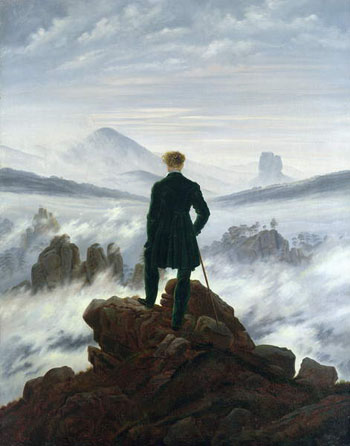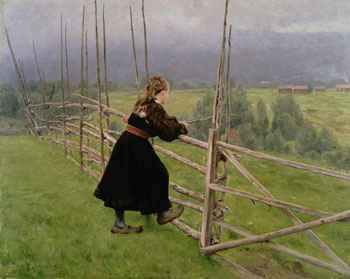Catholic Virtues
 |
 |
 |
 |
 |
 |
 |
True & False Paths to Happiness - XI
Sacral Contemplation, the Antidote
to Secularism
When one speaks of contemplation, an image that may come to mind is that of a hooded monk, looking upward at a shrine in a chapel or Church. Or that of a nun in full habit absorbed in considering the Sacred Heart of Jesus, the Immaculate Heart of Mary, the Angels or Saints. Or an anchorite in the desert, living in silence, poverty and isolation, making mortifications, rejecting the world.
Can a simple layman, who lives his life in the secular world dedicate himself to some type of contemplation? Should a layman speak of sacral contemplation?
Terminology is a relevant element in any study. Thus, in order to understand the scope of the subjects to be dealt with here, it is advisable to first clarify what precisely is meant by the word contemplation and, afterwards, set out how the adjective sacral will be understood.
Special meaning of contemplation
In the words of theologian Adolfo Tanquerey, "to contemplate, in general, is to look at an object with admiration." (Compêndio de Teologia Ascética e Mística, Porto, 6th ed., p. 145)
 Here we find part of the answer to the questions formulated above. For this definition highlights that it is possible to look at objects of temporal life with admiration. Furthermore, it is also necessary to consider the possibility of an auxiliary grace that can bring such an action to its summit, so long as the object of contemplation is appropriate.
Here we find part of the answer to the questions formulated above. For this definition highlights that it is possible to look at objects of temporal life with admiration. Furthermore, it is also necessary to consider the possibility of an auxiliary grace that can bring such an action to its summit, so long as the object of contemplation is appropriate.
Admiration is, therefore, the key to answering the question about the legitimacy of speaking of contemplation with regard to the temporal sphere.
The vocation of the so-called "contemplative monks" is extremely high, and we should refer to them with all respect and veneration. Whoever follows this vocation must have our full encouragement.
Once, in 1952, traveling through France, I passed in front of the famous Trappist monastery of Notre Dame de Sept Fons, where Dom Jean Baptiste Chautard (1858-1935) had been abbot. I wanted to descend from the automobile and step inside. I could not do so due to circumstances of the trip. Such is the high regard that should be given to monastic contemplation.
But there is another kind of contemplation different from the spirituality proper to a contemplative recluse, or even to a non-enclosed religious.
What is called sacral contemplation here corresponds to something in a certain way more general and, at the same time, more specific than the meaning currently attributed to the word contemplation. Something more general because its scope embraces the entire universe. Something more specific because it has well-defined roads, some of which will be presented below, others that may be indicated later.
Temporal society, a masterpiece of visible creation
Temporal society is the masterpiece of visible creation. Here we are not considering the Church, which must be seen from a different perspective. When God created the natural order, the masterpiece inside it was temporal society. The temporal society is, therefore, an excellent object of contemplation.
Whence comes the fact that temporal society is such a masterpiece of God?
It comes first of all from the nobility of man. Man is the king of creation. Temporal society, which is composed of these "kings," is more excellent than each "king" considered individually. Each man has the excellence of his nature, even with the effects of original sin. But the group of men that becomes society is more excellent than each individual man.
Correct contemplation of the temporal order
The correct contemplation of the temporal order must, therefore, be given its due value since it was instituted by the Creator principally so that men, also through it, might know, love and serve God.

 Through the contemplation of the temporal order, a man elevates his soul in the pinnacles of doctrine, where things assume a very special aspect. To do this, it is necessary to have the habit of considering from this altitude not only the facts of public life, but the facts of private life.
Through the contemplation of the temporal order, a man elevates his soul in the pinnacles of doctrine, where things assume a very special aspect. To do this, it is necessary to have the habit of considering from this altitude not only the facts of public life, but the facts of private life.
The man must have a habitually contemplative and meditative gaze when he looks at things in order to be a contemplative of earthly life. That is to say, he must be a person who looks at earthly life and is able to contemplate it.
This contemplation of earthly life is especially suitable for laymen, immersed as they are in temporal life. At first glance, there is nothing to be contemplated in earthly life. It is the day-to-day life with all its prosaic aspects, the professional life with all its routine, leisure with all its dispersion, etc.
However, Sacred Scriptures and, later, St. Thomas Aquinas (1) and St. Bonaventure (2) tell us that in every creature in the universe there is the image, likeness or vestige of God. In his Summa Theologiae, St. Thomas goes so far as to say that in every creature traces of the Holy Trinity can be found.
Sacral contemplation is, therefore, the contemplation of the image, likeness or vestiges of God in the universe – that is, in the world around us, in cities, families, institutions, art, animals, plants , in the details of each object.
Even when we are deeply absorbed in some occupation, this contemplation should be the second object of our attention in a continual search to understand the superior meaning of each thing.
A fully Christian temporal society
 Our sacral admiration should encompass practically everything: from nature to persons, peoples, History, passing through all human activities. Everything that is beautiful, good and true is the object of a contemplative spirit.
Our sacral admiration should encompass practically everything: from nature to persons, peoples, History, passing through all human activities. Everything that is beautiful, good and true is the object of a contemplative spirit.
Sacral contemplation presupposes a great sense of order, with special attention paid to groups, following the famous passage of Genesis that expresses God's appreciation of the universe He had just created: “All created things are good, but the whole is very good ” (Gen 1).
It also presupposes a high sensitivity to contrasts, which leads to the analysis of what is not good.
At the end of the road, sacral contemplation leads to the desire for a fully Christian Civilization: Christian in the religious sphere and Christian in the temporal sphere.
But it must be authentically Christian, where the adjective Christian does not constitute, as so often seen today, an empty buzzword, without any meaning. Filled with love, we desire the fulfillment of what we ask in the Our Father: "Thy Kingdom come." And that it come as soon as possible.
In this matter, we must want everything, as soon as possible and forever! Every truly Catholic heart should desire this.
Continued

Can a simple layman, who lives his life in the secular world dedicate himself to some type of contemplation? Should a layman speak of sacral contemplation?
Terminology is a relevant element in any study. Thus, in order to understand the scope of the subjects to be dealt with here, it is advisable to first clarify what precisely is meant by the word contemplation and, afterwards, set out how the adjective sacral will be understood.
Special meaning of contemplation
In the words of theologian Adolfo Tanquerey, "to contemplate, in general, is to look at an object with admiration." (Compêndio de Teologia Ascética e Mística, Porto, 6th ed., p. 145)

Admiration of the simple flowers around an Alpine house can lead us to God
Admiration is, therefore, the key to answering the question about the legitimacy of speaking of contemplation with regard to the temporal sphere.
The vocation of the so-called "contemplative monks" is extremely high, and we should refer to them with all respect and veneration. Whoever follows this vocation must have our full encouragement.
Once, in 1952, traveling through France, I passed in front of the famous Trappist monastery of Notre Dame de Sept Fons, where Dom Jean Baptiste Chautard (1858-1935) had been abbot. I wanted to descend from the automobile and step inside. I could not do so due to circumstances of the trip. Such is the high regard that should be given to monastic contemplation.
But there is another kind of contemplation different from the spirituality proper to a contemplative recluse, or even to a non-enclosed religious.
What is called sacral contemplation here corresponds to something in a certain way more general and, at the same time, more specific than the meaning currently attributed to the word contemplation. Something more general because its scope embraces the entire universe. Something more specific because it has well-defined roads, some of which will be presented below, others that may be indicated later.
Temporal society, a masterpiece of visible creation
Temporal society is the masterpiece of visible creation. Here we are not considering the Church, which must be seen from a different perspective. When God created the natural order, the masterpiece inside it was temporal society. The temporal society is, therefore, an excellent object of contemplation.
Whence comes the fact that temporal society is such a masterpiece of God?
It comes first of all from the nobility of man. Man is the king of creation. Temporal society, which is composed of these "kings," is more excellent than each "king" considered individually. Each man has the excellence of his nature, even with the effects of original sin. But the group of men that becomes society is more excellent than each individual man.
Correct contemplation of the temporal order
The correct contemplation of the temporal order must, therefore, be given its due value since it was instituted by the Creator principally so that men, also through it, might know, love and serve God.

The admiration of the things of Creation is a type of meditation, for old & young, male & female

The man must have a habitually contemplative and meditative gaze when he looks at things in order to be a contemplative of earthly life. That is to say, he must be a person who looks at earthly life and is able to contemplate it.
This contemplation of earthly life is especially suitable for laymen, immersed as they are in temporal life. At first glance, there is nothing to be contemplated in earthly life. It is the day-to-day life with all its prosaic aspects, the professional life with all its routine, leisure with all its dispersion, etc.
However, Sacred Scriptures and, later, St. Thomas Aquinas (1) and St. Bonaventure (2) tell us that in every creature in the universe there is the image, likeness or vestige of God. In his Summa Theologiae, St. Thomas goes so far as to say that in every creature traces of the Holy Trinity can be found.
Sacral contemplation is, therefore, the contemplation of the image, likeness or vestiges of God in the universe – that is, in the world around us, in cities, families, institutions, art, animals, plants , in the details of each object.
Even when we are deeply absorbed in some occupation, this contemplation should be the second object of our attention in a continual search to understand the superior meaning of each thing.
A fully Christian temporal society

We can admire all aspects of temporal society
Sacral contemplation presupposes a great sense of order, with special attention paid to groups, following the famous passage of Genesis that expresses God's appreciation of the universe He had just created: “All created things are good, but the whole is very good ” (Gen 1).
It also presupposes a high sensitivity to contrasts, which leads to the analysis of what is not good.
At the end of the road, sacral contemplation leads to the desire for a fully Christian Civilization: Christian in the religious sphere and Christian in the temporal sphere.
But it must be authentically Christian, where the adjective Christian does not constitute, as so often seen today, an empty buzzword, without any meaning. Filled with love, we desire the fulfillment of what we ask in the Our Father: "Thy Kingdom come." And that it come as soon as possible.
In this matter, we must want everything, as soon as possible and forever! Every truly Catholic heart should desire this.
Continued

- "In all created beings there is a vestige of the Holy Trinity. Every effect in some degree represents its cause, but in different ways. For some effects represent only the causality, not the form of the cause; as smoke represents fire. Such a representation is called a 'trace'; for a footprint shows that someone has passed by, but not who he is. Other effects represent the cause as regards the similitude of its form: thus the fire generated represents the generating fire, and a statue of Mercury represents Mercury. This type of representation is an image.
"Now, the processions of the Divine Persons take place according to the acts of intellect and will, as has been seen previously. For the Son proceeds from the intellect as a Word, and the Holy Spirit proceeds from the will as Love.
"Therefore, in rational creatures , endowed with intelligence and will, there is found the representation of the Trinity as an image, since in them there is the word conceived and the love that proceeds.
"But in all creatures there is a representation of the Trinity as a trace, inasmuch as in every creature are found things that necessarily refer to the Divine Persons as their cause. For every creature subsists in its own being, and has a form that determines its species, and has an order in relation to other beings. Therefore, as a created substance, it represents the cause and principle, and thus manifests the Person of the Father, who is the principle that has no beginning. As it has a certain form and species, it represents the Word, as the form of the work of art comes from the conception of the artist. And as it is ordered to other beings, it represents the Holy Spirit, which is Love, because the order of the effect in relation to something else comes from the will of the Creator.
"That is why St. Augustine says that the trace of the Trinity is found in every creature." (St. Thomas Aquinas, Summa Theologiae, I, q.45, a.7, c.) - "Visible things can be considered in two ways: either as an absolute thing, or as signs and signals leading to other things. In the first way, while loving and well-considering, the intellect and affection are absorbed in that thing; in the second way, they are invited by the visible appearance to proceed further because here the creature is considered as a sign that brings to mind something else." St. Bonaventure, I sent. d. 16a, 1q 2 ad 3, I, 281 b 282 a.
Posted June 12, 2020





